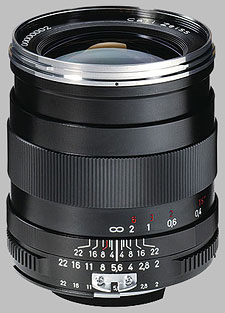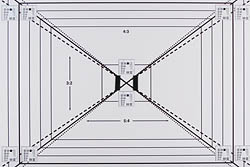| 28mm |
$1,283 average price |
|---|---|

|
|
Lab Test Results
Your purchases support this site
Canon EF - Black
(From Carl Zeiss lens literature) Modeled on current state-of-the-art lenses in this category, the Distagon T* 2/28 ZF features markedly improved optical quality. Thanks to the floating design, image quality remains almost consistent from the close-up range to infinity.
SLRgear Review
June 4, 2008
by Andrew Alexander
Carl Zeiss released the 28mm ƒ/2 Distagon without fanfare in the latter part of 2007, The lens is available in the Nikon F-mount, the Pentax/Samsung K-mount and the M42 screw mount.
The 28mm ƒ/2 is a full-frame lens, built to ''old-school'' specifications that guarantee compatibility with older camera bodies. On a sub-frame digital sensor body, the lens will have an effective field of view of about 42mm. The lens takes 58mm filters, and comes with a bowl-style metal lens hood.
Zeiss lenses can be tricky to find on store shelves, so your best bet is to check out the Carl Zeiss website and look for a local dealer.
Sharpness
If corner-to-corner sharpness is important, the lens can deliver it, but only if you stop down to ƒ/4 or ƒ/5.6 on a subframe digital sensor camera, or ƒ/5.6-ƒ/8 on a full-frame camera body.
The 28mm ƒ/2 Distagon produced softer results than we expected shot wide open. At ƒ/2 on our subframe D200 test body the lens shows around 1.5 blur units in the central region, and pronounced corner softness (4-5 blur units). This improved significantly by stopping down to ƒ/2.8, where the central region becomes tack-sharp, and corner softness is reduced to 3-4 blur units. By ƒ/4 there are just traces of corner softness, otherwise the image is tack-sharp across the frame. Diffraction limiting sets in at ƒ/11 and we start to see some generalized softness - not much between ƒ/11 and ƒ/16 - it's only at ƒ/22 that we see just under 3 blur units across the frame.
The 28mm ƒ/2 is an excellent example of how a lens has a ''sweet spot'' that can be taken advantage of by a digital subframe sensor camera body. Mounted on the full-frame D3, we noted extreme corner softness with the aperture set between ƒ/2 and ƒ/4. Central sharpness is as good at ƒ/2.8 and higher as noted above, but corner softness is remarkable - it actually goes off the test chart at ƒ/2 and ƒ/2.8.
So, good results for sharpness if you stop down, otherwise there is some corner softness on a sub-frame body, and major corner softness issues on a full-frame body. Whether this a good or a bad thing depends on your application. Portraits could benefit from the sharpness isolation, but where detail is important, you'll want to use this lens at smaller apertures, or not at all.
Chromatic Aberration
Chromatic aberration results for the 28mm ƒ/2 were also a bit surprising. As found in our lab tests for sharpness, our CA results underscore the poorer performance in the corners of the lens that are seen more on a full-frame body than on a sub-frame body.
On a subframe dSLR, CA is more of a factor when shot stopped down to ƒ/5.6 or greater. Wider than that (ƒ/2-ƒ/4) and CA performance is actually quite good - you only really see it in the corners. But smaller than ƒ/8 it becomes quite noticeable, especially at ƒ/11 or ƒ/16, where you're looking at CA results of 4/100ths of a percent of frame height generally, and over 7/100ths in the corners.
These results are a bit more pronounced on a full-frame camera such as our D3 test body (this lens is a great candidate for the D3's built in CA reduction). On the D3, Chromatic aberration is actually much worse in the corners when shot wide open, running contrary to the results we found when doing our test shots with the D200. This is of course because the D200 can't ''see'' the CA coming from the extreme edges of the glass. Its worst performance is shown at ƒ/5.6 or wider (ƒ/2-ƒ/4), but here the CA shows up in the corners - at over 7/100ths of a percent of frame height. Generally, it's not bad, and echoes the overall performance we noted on the subframe sensor, it's just those corners that really show it off (check out the sample pictures for some really obvious examples of this).
Of course, with the D3's built-in CA reduction, CA is dramatically reduced and isn't substantially a factor. To produce results that don't show this technical feature of the camera, we shot the results in RAW and converted them in Bibble.
Shading (''Vignetting'')
Results for corner shading are pretty much as you'd expect on a wide-angle lens - significant only when shot wide-open. On the sub-frame D200, we note just over a half-stop of corner darkening when used at ƒ/2, but after that, it's less than a quarter-stop difference. Curiously, at ƒ/11 and ƒ/16 this corner shading jumps up again to 1/3 of a stop darker.
On a full-frame camera body corner shading is much more of a factor. Shot wide open at ƒ/2, the corners are a full stop darker than the center of the frame. If this is critical the results can either be corrected in image post-processing software, or at the time of shooting with a central ND spot filter. Or you might like the look of the shaded vignetting. Stopping down gradually reduces the effect of the corner shading: 2/3 EV at ƒ/2.8, 1/3 EV at ƒ/4, and levelling out at a quarter-stop of difference at all other apertures.
Distortion
The Zeiss 28mm ƒ/2 shows a bit more barrel distortion than we'd like for a dedicated wide-angle prime: 0.2% average distortion, and 0.4% in the corners. These results are approximately the same regardless of sub- or full-frame camera application. This distortion can be fairly easily corrected in post-processing.
Autofocus Operation
The 28mm ƒ/2 Distagon is a manual focus lens.
Macro
With a 0.20x (1:5) magnification ratio, the 28mm ƒ/2 wouldn't be classed as a macro lens. That said, its minimum close-focus range is 24cm (10 inches), and given the length of the lens this means you can take photos from only 4 inches away from your subject.
Build Quality and Handling
Carl Zeiss seems to have taken a retro approach with its line of ZF lenses, in that instead of adopting a new design approach they are solidly capitalizing on a proven concept of an old design. The sample we tested is built with the old Nikon ''rabbit-ears'' AI indexer, to ensure compatibility with some of the oldest Nikon bodies produced.
The lens is composed of 10 elements in 8 groups. Nine rounded diaphragm blades make up the aperture. The production quality of the lens is superb; the entire construction is metal, from lens mount to filter rings. Accordingly, this makes it rather heavy at 530g (almost 1.2 lbs). Unless your newer camera body supports AI- or AIS-style lenses, you can forget about ''advanced'' modes such as aperture priority; it will be manual mode all the way. And you would forget about metering, as well. My sense is that the average purchaser of this lens will not have such problems.
Those issues aside, the lens is wonderfully presented, with a distance and magnification scale etched into the focus ring. A depth-of-field scale (complete with infrared index) is adjacent to the aperture ring. The aperture ring itself clicks between ƒ/2 and ƒ/22 in half-stop intervals. A 3/4-inch deep metal bayonet-style lens hood completes the ensemble. The lens hood can be reversed for storage on the lens.
The focus ring is the main operating feature of the lens, at 5/8 of an inch wide, with a ribbed metal texture. Slightly less than a half-turn (150 degrees) brings you from closest focus to infinity. The lens takes 58mm filters.
Alternatives
Nikon 28mm ƒ/2.8D AF ~$225
If you can't live without autofocus on a Nikon platform, this is the lens you need at this focal length. Build quality is not as good as the Nikkor 28mm ƒ/2 AI/AIS; it's also a full stop slower than that lens or the Zeiss. If low-light capability is important there is the 28mm ƒ/1.4 AF, discontinued, in very short supply and selling used in the thousands of dollars. The Nikkor 28mm ƒ/2.8 weighs much less (1/2 the weight), is also full-frame, and takes 52mm filters.
Nikon 28mm ƒ/2 AI / AIS ~$300
If you can find this lens used, you'll pay much less than the Zeiss model, for comparable build quality. It's anyone's guess how the lens performs optically.
Pentax 28mm ƒ/2.8 AL SMC P-FA ~$200
The Pentax offering in 28mm is very light (185g) and employs autofocus. It uses a simple design: 5 elements. It's also a full-frame lens but uses 49mm filters, comparatively rare on SLR systems.
Sigma 28mm ƒ/1.8 EX DG Aspherical Macro ~$260
The Sigma comparable in the 28mm category is actually a third of a stop faster, and weighs about the same as the Zeiss. It has autofocus as well as a macro capability (0.34x). It takes large 77mm filters. We haven't tested it, but user reviews suggest it shows soft performance wide open.
Conclusion
When Rob Galbraith asked Kornelius Mueller of Zeiss about the anticipated performance of a Zeiss 28mm ƒ/2, Mueller speculated that corner softness and CA would be better than present models. Based on test results, Zeiss hasn't produced a significant improvement; corner softness, corner shading and CA are particularly bad, though you'll really only see these issues on a full-frame camera body.
These issues aside, as well as the fact that you're essentially working with 60's era technology, the Zeiss 28mm ƒ/2 is a pleasant departure from plastic polycarbonate construction. Used just a few stops in, it produces razor-sharp results and is very nice to work with. I don't know if the premium price is justified, given the corner performance, but chances are if you're reading this review you already know if you want it, and aren't scared off by a trifling detail such as sticker price.
Sample Photos
The VFA target should give you a good idea of sharpness in the center and corners, as well as some idea of the extent of barrel or pincushion distortion and chromatic aberration, while the Still Life subject may help in judging contrast and color. We shoot both images using the default JPEG settings and manual white balance of our test bodies, so the images should be quite consistent from lens to lens.
As appropriate, we shoot these with both full-frame and sub-frame bodies, at a range of focal lengths, and at both maximum aperture and ƒ/8. For the ''VFA'' target (the viewfinder accuracy target from Imaging Resource), we also provide sample crops from the center and upper-left corner of each shot, so you can quickly get a sense of relative sharpness, without having to download and inspect the full-res images. To avoid space limitations with the layout of our review pages, indexes to the test shots launch in separate windows.
Carl zeiss 28mm f/2 Distagon T* 2/28
Your purchases support this site
Canon EF - Black
Carl Zeiss 28mm f/2 Distagon T* 2/28 User Reviews
The Carl Zeiss 28mm f/2 Distagon T* 2/28 doesn't have any user reviews yet!









